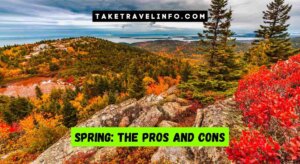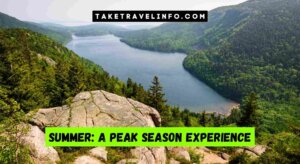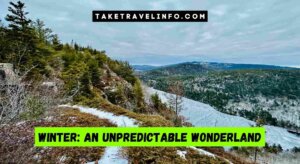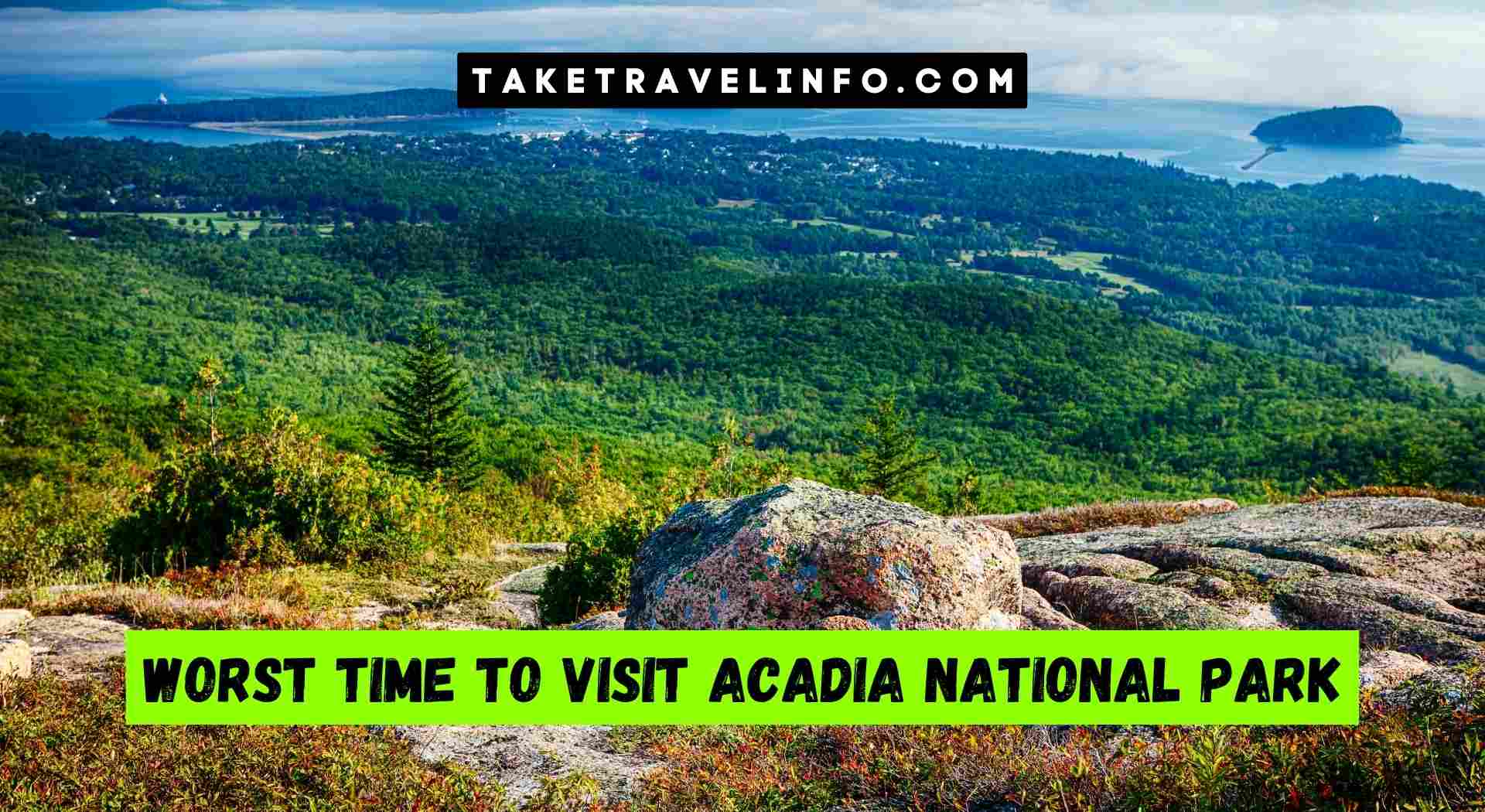The worst time to visit Acadia national park is during the winter months due to extremely cold temperatures and limited accessibility. Situated along the coast of Maine, Acadia national park offers breathtaking views of the Atlantic Ocean, rugged mountains, and a diverse range of wildlife.
However, the winter months bring freezing temperatures, heavy snowfall, and icy conditions, making it difficult to explore the park’s trails and roads. Additionally, many facilities and services within the park are closed during this time, limiting the visitor experience.
To fully enjoy and take advantage of Acadia national park’s beauty and recreational opportunities, it is best to plan your visit during the warmer months when the park is fully accessible and vibrant with outdoor activities.
Weather Considerations: The Main Factor
Acadia national park offers a picturesque landscape filled with stunning vistas, scenic trails, and diverse wildlife. While the park remains a popular destination throughout the year, there are certain times when visiting may not be as pleasant or ideal. One important factor to consider when planning your trip to Acadia is the weather.
With its location along the rugged coast of Maine, the park experiences a variety of weather conditions throughout the year. Let’s delve into the weather considerations that can greatly impact your experience at Acadia national park.
Spring: The Pros And Cons

Blooming Landscapes: Enjoying Acadia’S Natural Beauty At Its Peak
Springtime in Acadia national park brings forth a vibrant burst of colors as the landscapes come alive with blooming flowers and trees. The park transforms into a mesmerizing sight, with vibrant hues painting the backdrop of stunning vistas. From delicate wildflowers to grand displays of rhododendrons and azaleas, visitors are treated to a visual feast like no other.
The blooming landscapes of Acadia during spring are indeed a sight to behold.
- The park showcases a stunning display of wildflowers, including lupines, trilliums, and orchids.
- Rhododendrons and azaleas create stunning pops of color against the backdrop of the park’s diverse ecosystems.
- Hiking trails wind through landscapes adorned with blooming trees, creating picturesque scenes at every turn.
Rainfall And Foggy Conditions: Potential Challenges For Outdoor Activities
While springtime brings beauty to Acadia, it is also known for its unpredictable weather patterns. Rainfall and fog are common during this season, which could pose challenges for those planning outdoor activities.
- Rainfall can create muddy conditions on trails, making hiking more challenging and less enjoyable.
- Foggy conditions can limit visibility, making it difficult to fully appreciate the panoramic views that Acadia is famous for.
- Outdoor activities such as camping and picnicking may be impacted by the wet weather, requiring proper preparation and flexibility.
Wildlife Sightings: Spotting Migratory Birds And Newborn Animals
Spring is a prime time for wildlife sightings in Acadia national park. As migratory birds return to their breeding grounds, visitors have the opportunity to witness fascinating behaviors and spot a variety of bird species. Additionally, the arrival of spring brings with it the birth of new animals, providing a heartwarming sight for nature enthusiasts.
- Migratory birds, including warblers, falcons, and herons, make their way back to Acadia, offering a unique birdwatching experience.
- The park’s diverse ecosystems provide habitat for a rich array of wildlife, and springtime allows for sightings of newborn animals such as fawns, fox kits, and bear cubs.
- Wildlife photographers will find spring to be an ideal time to capture captivating images of animals in their natural habitat.
Spring in Acadia national park presents both opportunities and challenges. The blooming landscapes offer a stunning visual experience, while the unpredictable weather and wet conditions can hinder outdoor activities. However, the chance to witness migratory birds returning and newborn animals emerging makes spring an exciting time for wildlife enthusiasts.
Despite its drawbacks, experiencing Acadia in the spring is an adventure filled with nature’s wonders.
Summer: A Peak Season Experience

Sunny Skies And Warm Temperatures: Perfect Conditions For Outdoor Activities
- The summer season in Acadia national park is known for its sunny skies and warm temperatures, making it the perfect time for outdoor enthusiasts to indulge in various activities.
- With an average high temperature of 75 degrees Fahrenheit, visitors can enjoy hiking, biking, camping, and swimming in the park’s pristine lakes and ponds.
- The longer daylight hours during summer offer ample time to explore the park’s breathtaking landscapes and take in the stunning coastal views.
Crowded Trails And Roads: Managing The Influx Of Tourists And Parking Difficulties
- As summer is the peak season, the trails and roads of acadia national park tend to get crowded with tourists from all over the world.
- Popular hiking trails like Jordan pond path and Precipice Trail can become congested, requiring patience and careful maneuvering to navigate through the crowd.
- The parking areas at the trailheads often fill up quickly, making it challenging to find suitable parking spots. Arriving early in the day or utilizing the park’s shuttle system can help mitigate these challenges.
Book Accommodations In Advance: Avoiding Last-Minute Disappointments
- Due to the high demand and popularity of acadia national park during the summer season, it is crucial to book accommodations well in advance to secure a place to stay.
- The park’s campgrounds and lodging options, including hotels and cabins, tend to fill up quickly, leaving little availability for spontaneous travelers.
- By planning and making reservations in advance, visitors can avoid the disappointment of not finding suitable accommodations during their visit.
Visiting Acadia national park during summer offers a remarkable experience of enjoying the beautiful weather and engaging in various outdoor activities. However, it’s important to prepare for the challenges that come with peak season visitation, such as crowded trails and roads, as well as the need to book accommodations in advance.
By understanding and planning for these factors, visitors can make the most of their summer adventure in this stunning national park. So start packing your bags, and get ready to create unforgettable memories amidst the natural wonders of Acadia national park.
Fall: A Colorful Adventure

Vibrant Foliage: Experiencing Acadia’S Picturesque Autumn Landscapes
- The fall season at Acadia national park is a sight to behold with its vibrant foliage. The changing colors of the leaves paint a picturesque landscape that is truly mesmerizing.
- The park’s diverse range of trees, including maple, oak, and birch, showcase an array of warm hues such as golden yellows, fiery oranges, and deep reds.
- The combination of the park’s rugged coastline, granite peaks, and colorful foliage creates a breathtaking backdrop for outdoor enthusiasts and nature lovers.
Cooler Temperatures: Suitable For Long Hikes And Explorations
- Fall brings cooler temperatures to Acadia national park, making it the perfect time for outdoor activities such as hiking and exploring.
- The milder climate allows visitors to enjoy the beauty of the park without the scorching heat of summer or the biting cold of winter.
- The crisp autumn air energizes hikers and provides a refreshing experience while traversing the park’s extensive trail system.
Popular Time For Travelers: Planning For Crowds And Accommodation Availability
- Fall is a popular time for travelers to visit Acadia national park due to its stunning fall foliage and comfortable weather.
- However, it also means planning for crowds and ensuring accommodation availability. It is advisable to make reservations well in advance to secure your preferred lodging option.
- Despite the influx of tourists, the park’s vast expanse provides ample space for everyone to explore and appreciate the natural wonders of Acadia.
Fall is an enchanting season in Acadia national park, offering vibrant foliage, cooler temperatures for outdoor adventures, and a popular time for travelers. Embrace the colorful adventure and immerse yourself in the captivating beauty of this remarkable destination.
Winter: An Unpredictable Wonderland

If you’re seeking a unique and adventure-filled experience in Acadia national park, visiting during the winter months can offer just that. While it may not be the most popular time to visit, the winter season brings a tranquil atmosphere and a host of activities for those willing to embrace the cold.
However, it’s important to be aware of the challenges and limitations that come with visiting Acadia in the winter.
Tranquil And Secluded Atmosphere: The Park’S Quietest Time Of The Year
During the winter months, acadia national park transforms into a serene and secluded wonderland. With fewer visitors and the absence of bustling crowds, you can truly immerse yourself in the tranquility of nature. The peacefulness of the park during this time allows for a deeper connection with the surroundings and a chance to experience an unmatched sense of solitude.
Limited Accessibility: Dealing With Road And Trail Closures
However, visiting Acadia national park in the winter does come with its own set of challenges. One of the main considerations is the limited accessibility due to road and trail closures. Harsh winter weather conditions can cause roads and trails to be impassable, with snow and ice rendering them unsafe for travel.
It’s essential to check the park’s website or contact the visitor center before your visit to stay informed about any closures or restrictions.
Here are some key points to keep in mind regarding limited accessibility:
- Some popular areas of the park, including Cadillac Mountain and Jordan Pond, may not be accessible due to road closures.
- Hiking trails may be inaccessible or require additional precautions due to snow and ice.
- It’s crucial to come prepared with suitable transportation, such as a four-wheel drive vehicle, and proper winter gear to navigate the park safely.
Winter Activities: Ice Skating, Cross-Country Skiing, And Snowshoeing Opportunities
Despite the limitations, Acadia national park offers a whole array of winter activities to enjoy amidst its picturesque landscapes. The snow-covered terrain opens up opportunities for thrilling adventures and unique experiences. Here are some activities you can partake in:
- Ice skating: Lace up your skates and glide across frozen ponds and lakes within the park. It’s a magical way to embrace the winter wonderland and enjoy the beauty of Acadia from a different perspective.
- Cross-country skiing: Explore the park’s trails on skis, immersing yourself in the peaceful surroundings while getting a great workout. The vast network of groomed cross-country skiing trails provides endless opportunities for exploration.
- Snowshoeing: Strap on a pair of snowshoes and venture into the park’s snow-covered wilderness. From easy strolls to more challenging treks, snowshoeing allows you to access areas that may be inaccessible during other seasons and discover hidden gems along the way.
As you plan your visit to Acadia national park in the winter, be sure to check local weather conditions and stay updated on any safety advisories. With the right preparations and an adventurous spirit, you can experience a truly unforgettable winter wonderland in Acadia.
Frequently Asked Questions Of Worst Time To Visit Acadia National Park
What Are The Downsides Of Visiting Acadia National Park In Summer?
Visiting Acadia national park in summer means dealing with larger crowds, especially at popular sights like Cadillac Mountain and the precipice trail. Traffic can also be heavy, making it challenging to navigate the park. Additionally, the summer humidity and temperatures can be quite uncomfortable, especially for outdoor activities.
Can You Provide Alternate Times To Visit Acadia National Park?
If you want to avoid the crowds, consider visiting Acadia national park in the shoulder seasons of spring and fall. During May and June or September and October, you’ll experience pleasant weather, fewer tourists, and lower accommodation rates. The park’s stunning foliage in the fall is an added attraction during these times.
Are There Any Specific Events Or Factors To Consider Before Planning A Visit?
Yes, it’s important to consider a few factors before planning your visit to Acadia national park. For instance, if you’re an avid hiker, the best time to visit is when the park’s trails are snow-free, usually from late spring to early fall.
Additionally, keep an eye on any road closures or construction work that may impact your itinerary.
Are There Any Parts Of Acadia National Park That Are Less Crowded During Peak Season?
While some popular areas like Jordan Pond and sand beach tend to get crowded during peak season, you can still find relatively quieter spots in Acadia national park. Places like the Schoodic Peninsula and Isle au Haut offer scenic beauty and hiking opportunities with fewer crowds, ideal for those seeking a quieter experience.
What Are The Advantages Of Visiting Acadia National Park During The Off-Peak Season?
Visiting Acadia national park during the off-peak season, such as winter, allows you to enjoy the park’s tranquil beauty without the usual crowds. You can find solitude on the trails and experience breathtaking snowy landscapes. Additionally, accommodation rates are lower, making it more affordable to stay in the park or nearby areas.
Conclusion
To make the most of your trip to Acadia national park, it is crucial to consider the best time to visit. While the park offers stunning natural beauty throughout the year, certain periods may not be as favorable for an optimal experience.
The winter months, specifically January and February, can be harsh with heavy snowfall and bitterly cold temperatures, making outdoor activities challenging. Additionally, the summer months, particularly July and August, tend to be crowded with tourists, resulting in longer waits and less serene surroundings.
Therefore, the best time to visit Acadia national park is during the shoulder seasons of spring (April to June) and fall (September to October). During these months, visitors can enjoy pleasant weather, fewer crowds, and a plethora of activities, such as hiking, birdwatching, and cycling.
Whether you are a nature enthusiast or a casual traveler, planning your visit during these optimal periods will guarantee an unforgettable experience in Acadia national park.


2 thoughts on “Worst Time to Visit Acadia National Park”